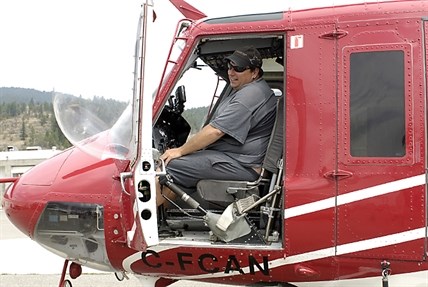
Wildcat Helicopters engineer Kris Wortley, pilots Robert Stevens and Don McManus, engineer Jeff Kryczka and branch director Larry Legasy with one of four helicopters used to fight the Smith Creek fire in West Kelowna.
(ADAM PROSKIW / iNFOnews.ca)
July 25, 2014 - 9:56 AM
KELOWNA – If you ask the helicopter pilots about their role in bringing the 400 hectare Smith Creek wildfire under control, they’ll probably tell you it was all in a day’s work.
Pilot Robert Stevens flies one of four Bell 212 helicopters Wildcat uses to fight fires for the province. When the Smith Creek blaze broke out in West Kelowna last Thursday, he was already working another fire at Tumbler Ridge.
Within a couple days he was moved to West Kelowna and by Monday he was making up to 92 water pickups and 92 drops over each five and a half hour shift.
“We were averaging a tank load every two to four minutes depending on where we were going,” he says.
At 350 gallons per tank, that’s enough to fill a swimming pool in just 15 minutes.
Stevens, who was a firefighter in Ontario in the late '80s, has been flying professionally for 25 years. He says he knew after his first flight in a helicopter that it’s what he wanted to do.
“I’ve been around aircraft my whole life,” he says. “Helicopters just seemed like a better way to fight fires than a fixed wing aircraft.”
Stevens, who is still on standby in case of hot spots, says despite the size of the fire he never once doubted they’d get it under control.
“We knew we had it," he says. "Our focus was first on containing the fire so it didn’t spread to the houses, We just set up a perimeter and worked our way in from there.”
The flights involved picking up water at either Shannon Lake or a relay tank, and dropping it at spots chosen by an airborne Helco, or Helicopter Controller.
“We were down to tree-top level,” he says. “It depends on what type of drop you want to do and what the winds are doing but sometimes you have to get really low because of the wind.”
More wind means more dispersal. There are four doors to the water tank that can be opened all at once for a fast drop or one at a time to cover more area. Stevens says he used every combination while fighting the Smith Creek wildfire.
Stevens spends his downtime relaxing and hanging out with the ground crew.
“Sometimes you do minor maintenance, you clean up the machine, talk to the engineers,” he says. “Basically just stay ready for a call.”
With a home in Kelowna, Stevens says this firefight brought back some painful memories from 2003 when he and his family were evacuated and nearly lost their home in the Mission.
“We had 19 places on our street that got lost in the fire,” he says. “We were very lucky.”
Stevens says a high point for him over the last week has been seeing the outpouring of support from the community.
“There was one house that put a banner on their roof that said 'thank you',” he says. “That tends to make it more personal. It’s not just a house, it’s a family.”

Wildcat Helicopters pilot Robert Stevens and the Bell 212 he used to fight the Smith Creek fire.
(ADAM PROSKIW / iNFOnews.ca)
To contact the reporter for this story, email Adam Proskiw at aproskiw@infotelnews.ca or call 250-718-0428. To contact the editor, email mjones@infotelnews.ca or call 250-718-2724.
News from © iNFOnews, 2014